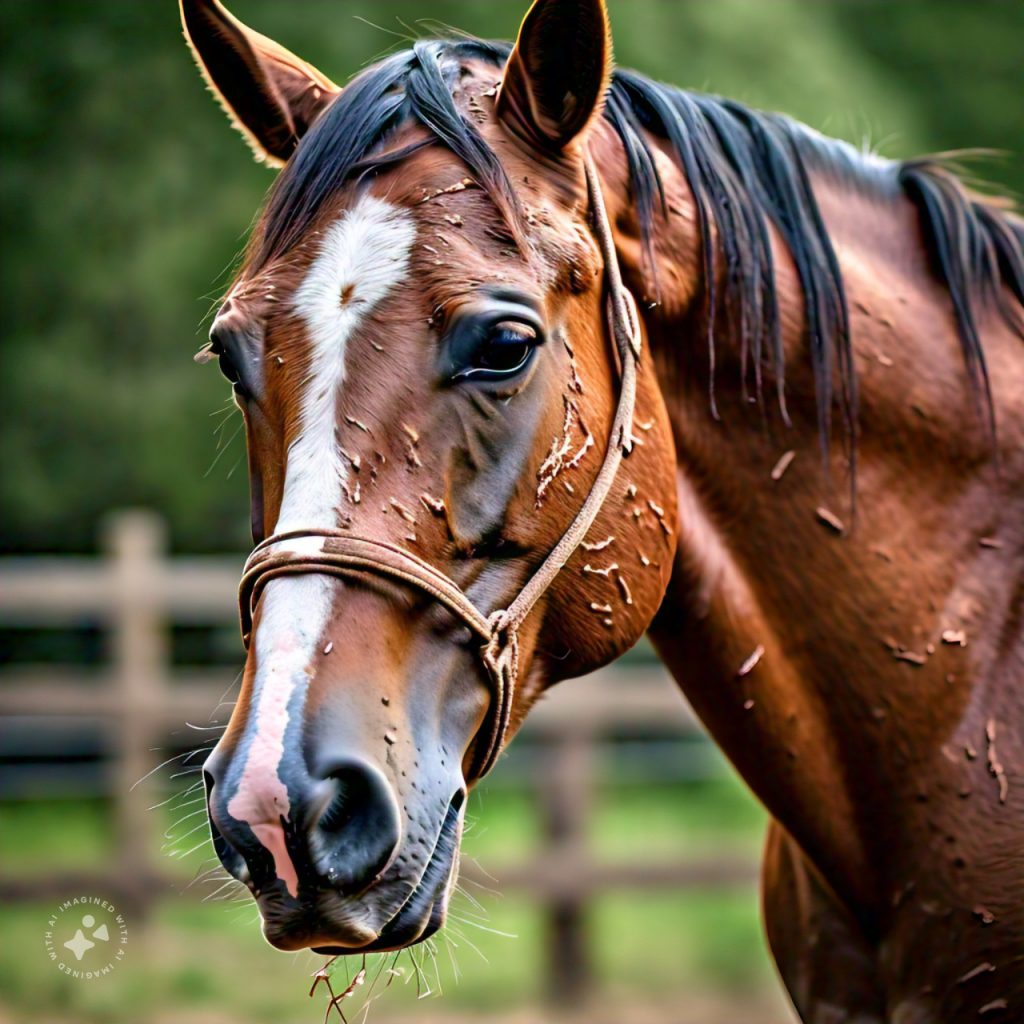Horse owners know that maintaining a horse’s skin health is crucial for their overall well-being and performance. Skin conditions in horses can arise from various causes, including parasites, infections, allergies, and environmental factors. Early recognition and proper management are essential to prevent complications. This article provides an in-depth breakdown of common equine skin conditions, their symptoms, causes, and treatment options.
1. Rain Rot (Rain Scald)
Overview:
Rain rot, caused by the bacterium Dermatophilus congolensis, is one of the most common skin infections in horses. It occurs when the skin becomes excessively moist, creating an environment conducive to bacterial growth.
Symptoms:
- Crusty scabs that peel off, revealing raw skin.
- Hair loss in affected areas, often leaving a patchy coat.
- Lesions typically appear on the back, neck, and rump.
Causes:
- Prolonged exposure to wet or humid conditions.
- Sharing grooming tools or tack with infected horses.
Treatment:
- Isolate the infected horse to prevent spread.
- Clean the affected area with an antimicrobial shampoo.
- Allow the skin to dry thoroughly and apply topical treatments as recommended by a veterinarian.
Prevention Tips:
- Provide shelter during rainy weather.
- Regularly disinfect grooming equipment and tack.
2. Sweet Itch (Summer Itch)
Overview:
Sweet itch, also known as Culicoides hypersensitivity, is an allergic reaction to the bites of midges (Culicoides spp.).
Symptoms:
- Intense itching, leading to scratching and self-inflicted wounds.
- Hair loss and thickened skin, especially along the mane, tail, and belly.
- Restlessness and discomfort.
Causes:
- Allergic response to midge saliva.
- Occurs more frequently in warm, humid climates.
Treatment:
- Apply insect-repellent sprays and use fly sheets to protect the horse.
- Corticosteroid creams or antihistamines may be prescribed for severe cases.
- Keep the horse in a well-ventilated stall during peak midge activity.
Prevention Tips:
- Use insect traps and fans in the barn.
- Apply insect repellents consistently.
3. Ringworm
Overview:
Ringworm, despite its name, is a fungal infection, not a worm infestation. It is highly contagious and affects horses of all ages.
Symptoms:
- Circular patches of hair loss with scaly, crusty skin.
- Itching, though less severe compared to other conditions.
- Lesions often appear on the face, neck, and girth area.
Causes:
- Infection by fungi such as Trichophyton or Microsporum species.
- Spread through contaminated brushes, tack, or direct horse-to-horse contact.
Treatment:
- Isolate the infected horse to prevent transmission.
- Use antifungal shampoos or creams as prescribed by a veterinarian.
- Disinfect all tack, grooming tools, and bedding.
Prevention Tips:
- Maintain hygiene and avoid sharing equipment among horses.
- Quarantine new horses before introducing them to the herd.
4. Scratches (Mud Fever)
Overview:
Scratches, or pastern dermatitis, is an inflammatory condition affecting the lower legs. It commonly occurs in horses exposed to wet or muddy conditions.
Symptoms:
- Redness, swelling, and scabs on the pasterns.
- Cracked skin that may ooze or become infected.
- Lameness in severe cases.
Causes:
- Prolonged exposure to moisture.
- Bacterial, fungal, or parasitic infections.
Treatment:
- Clean and dry the affected area thoroughly.
- Apply antiseptic ointments and keep the area clean.
- Severe infections may require systemic antibiotics or antifungals.
Prevention Tips:
- Avoid turnout in excessively wet or muddy fields.
- Keep the horse’s legs clean and dry.
5. Hives (Urticaria)
Overview:
Hives are raised, swollen welts that develop on the skin due to an allergic reaction.
Symptoms:
- Sudden appearance of raised, soft lumps on the skin.
- Itching and discomfort.
- Lesions can appear anywhere on the body.
Causes:
- Allergies to food, insect bites, medications, or environmental factors.
- Stress or changes in diet.
Treatment:
- Identify and eliminate the allergen if possible.
- Administer antihistamines or corticosteroids as prescribed by a vet.
- Cold hosing or applying soothing ointments can provide relief.
Prevention Tips:
- Introduce new feeds or supplements gradually.
- Minimize exposure to known allergens.
6. Lice and Mites
Overview:
Parasitic infestations by lice or mites can cause significant skin irritation.
Symptoms:
- Persistent itching and rubbing.
- Hair loss and scabs, particularly on the mane, tail, and legs.
- Visible parasites in severe infestations.
Causes:
- Poor hygiene or close contact with infected animals.
- Overcrowded living conditions.
Treatment:
- Use medicated shampoos or powders to kill parasites.
- Treat all horses in the herd to prevent reinfestation.
- Disinfect stalls, tack, and grooming tools.
Prevention Tips:
- Regular grooming and inspections.
- Maintain clean and hygienic stables.
Conclusion
Skin conditions in horses can range from minor irritations to severe infections requiring veterinary care. Regular grooming, maintaining clean living conditions, and early intervention are key to preventing and managing these conditions. If you notice any unusual skin changes, consult your veterinarian promptly for an accurate diagnosis and treatment plan.
FAQs
Q: How can I prevent skin conditions in my horse?
A: Regular grooming, maintaining dry and clean living conditions, and minimizing exposure to potential irritants or allergens are effective preventive measures.
Q: Are skin conditions contagious among horses?
A: Some conditions, like ringworm and lice, are highly contagious. Proper hygiene and isolation of affected horses are crucial.
Q: When should I call a vet for my horse’s skin condition?
A: If the condition worsens, spreads rapidly, or does not improve with basic care, seek veterinary advice.
Q: Can diet affect my horse’s skin health?
A: Yes, a balanced diet rich in essential nutrients supports healthy skin and coat.
Q: Is it safe to use human skin treatments on horses?
A: Always consult a veterinarian before using human products, as some may be harmful to horses.
By staying informed and proactive, horse owners can ensure their equine companions remain healthy and comfortable, free from common skin ailments.

